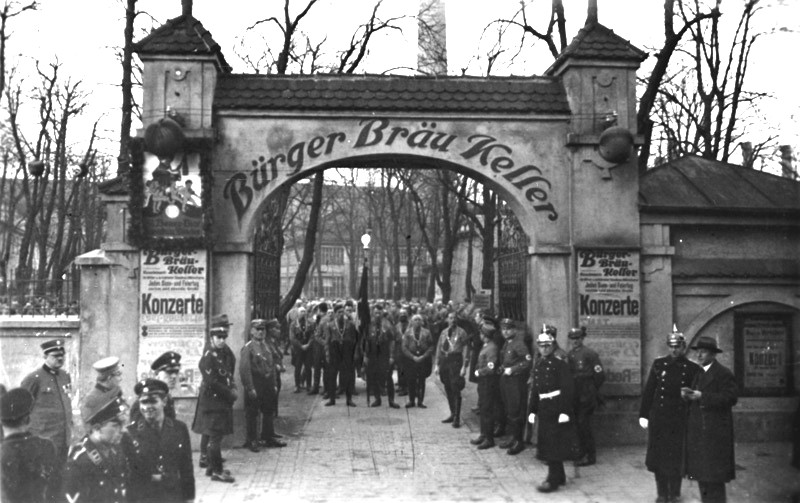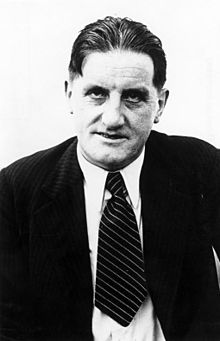On September 12th, 1919, Hitler went to a meeting of the German Workers' Party in the back room of a Munich beer hall. Dressed in civilian attire he listened to a speech on economics.
After the speech, Hitler became enraged when a man rose up and spoke in favor of the German state of Bavaria breaking away from Germany and forming a new South German nation with Austria.
Hitler then spoke out forcefully against the man. When he was finished one of the founders of the German Worker's Party gave Hitler a forty-page pamphlet entitled: "My Political Awakening" and invited him to come back again. A few days later, Hitler received an unexpected postcard saying he had been accepted as a member into the party.
Hitler was now one of the seven members of the German Worker's Party executive committee. At first the Committee had a difficult time enticing people to attend their rallies.
On October 16th, Hitler was a featured speaker for the first time at the a rally. It was said that people had their doubts about Hitler's abilities, but after his speech that night, the other members all decided that from then on Hitler would be featured as the main attraction at the meetings. In his speeches Hitler delivered anti-Semitic tirades, blaming the Jews for Germany's problems.
By 1920, Hitler had taken over charge of the propaganda for the party. He designed the party's banner of a swastika in a white circle on a red background. Hitler described what the banner was supposed to mean. "In the red we see the social idea of the movement, in the white the national idea, in the swastika the mission to struggle for the victory of Aryan man and at the same time the victory of the idea of creative work, which is eternally anti-Semitic and will always be anti-Semitic."
With the help of army Captain Ernst Röhm, Hitler recruited men he had known in the Army and along with the distaste for the peace brought on by the Treaty of Versailles, which made many Germans feel humiliated and the resulting democratic republic, the members of the German Workers' Party started to steadily grow.
Ernst Röhm was known as a fanatical, simple-minded swashbuckler who frequently displayed contempt for danger. He was born in Munich, the youngest of three children. His father Julius, a railway official and was strict, but when he realized that his son didn't respond to that kind of parenting, let up the reins quit a bit.
Röhm entered the Royal Bavarian 10th Infantry Regiment Prinz Ludwig at Ingolstadt on July 23rd, 1906. By the time of the outbreak of WWI, he had been promoted an officer’s rank. Röhm was wounded three times, leaving him with noticeable facial scarring. The injuries he suffered at Verdun in 1916 lead him to spending the remainder of the war in France and Romania as a staff officer. He was also awarded the Iron Cross First Class.
During the autumn of 1918, he contracted the Spanish flu and was not expected to live, but he did.
After WWI ended, Röhm continued his military career as a captain. He was one of the senior members which overturned the Munich Soviet Republic by force of arms.
In 1919 he joined the German Workers' Party and that is how he met Hitler.
On February 24th, 1920, the German Workers' Party held its first mass meeting in which Hitler outlined it's Twenty Five Points. The points basically are that all the Germans in Germany must unite and that they reject the the Treaty of Versailles. Also that the German people are entitled to more land that they currently had. No Jew was to be considered a German. All income not earned by work was to be confiscate. The national education system needed to be reconstructed and all religious freedom was acceptable... well except for religions which endangered the German race. The last point was a strong central government for the execution of effective legislation.
On March 31st, 1920 Hitler was discharged from the army and began working full-time for what was now called the National Socialist German Workers Party.
In April of 1921, Allies of World War I, notably France and Britain, presented a 33 billion dollar bill to Germany demanding payment for damages caused in the war which Germany had started. German currency slipped drastically in value. The German government asked for a postponement of payments, but the French refused. So Germany had not choice but to default on it's payments. Germans lost their life savings. Germany's money was basically worthless and not many people could afford to buy groceries. Hunger riots broke out.
In June 1921, Hitler was on a fundraising trip to Berlin, a mutiny broke out within the NSDAP in Munich. They kind of thought Hitler was acting like a tyrant. Hitler returned to Munich on July 11th and angrily tendered his resignation. The committee members realized that the resignation of their leading public figure and speaker would probably mean the end of the party. Hitler announced he would rejoin on the condition that he would take over as party chairman, and that the party headquarters would remain in Munich. The committee agreed and at the next gathering Hitler was introduced as Führer of the Nazi Party.
In 1923 Hitler decided to try to attempt a coup called the "Beer Hall Putsch" and bring down the democratic government.
With the help of World War I General Erich Ludendorff, Hitler and the Nazis hatched a plot in which they would kidnap the leaders of the Bavarian government and force them at gunpoint to accept Hitler as their dictator.
Erich Ludendorff was known as the man of iron principles. He was born in Kruszewnia, Prussia. He was the third of six children of August Wilhelm Ludendorff and Klara Jeanette Henriette von Tempelhoff. His father was descended from Pomeranian merchants, was an impoverished land owner and cavalry captain. His mother was a member of an aristocratic military family.
He grew up on a farm and received his early schooling from his maternal aunt and had a gift for mathematics. He passed the entrance exam for the Cadet School at Plön and he did so well that he was put in a class two years ahead of his age group. He also was first in every class.
Ludendorff became an infantry officer and was soon promoted to the general staff. He was then put in charge of the 2nd department, which was responsible for preparing contingency deployment and mobilization plans.
Ludendorff met Margarethe Schmidt in a rainstorm when he offered his umbrella. Schimdt's father was a wealthy factory owner. In 1910 Ludendorff and Schimdt were married. She has divorced her previous husband to marry Ludendorff and so brought three stepsons and a stepdaughter into the picture. Ludendorff ended up being a wonderful and devoted father to those children.
He began campaigning for a strengthening of the army. His constant campaigning irritated the military authorities, and in 1913 Ludendorff was transferred to the infantry as regimental commander. When war broke out in 1914, he was appointed quartermaster in chief of the 2nd Army. When two Russian armies threatened to overrun the German 8th Army in East Prussia Ludendorff was appointed chief of staff of the 8th Army.
Ludendorff was victorious over the Russians in August 1914 at Tannenberg, in East Prussia. However, the admiration was short lived following the German defeat on the Marne in the west that signaled the failure of Ludendorff’s revised Schlieffen Plan.
In August 1916, the emperor finally appoint two generals to assume supreme military control. Ludendorff was one of those generals. In 1917 he approved the unrestricted submarine warfare against the British that led to the entry of the United States into the war against Germany. After the tsar had been deposed in March 1917, Ludendorff gave his blessing to the return of the Russian Bolshevik emigrants, in the hope of persuading the Russians to conclude peace. Ludendorff also brought about the dismissal of Chancellor Theobald von Bethmann Hollweg.
On March 21, 1918, Ludendorff opened a general offensive on the Western Front with the object of smashing the Anglo-French armies, but he had overestimated the strength of the German armies and the offensive failed. In Autumn, the collapse of the German allies—Austria-Hungary, Bulgaria, and Turkey was imminent, so Ludendorff demanded immediate negotiations for an armistice. He became highly stressed and a psychiatrist was called in. Eventually he tendered his offered his resignation, which William II accepted on Oct. 26, 1918.
Ludendorff was hidden by his brother and a network of friends until the next month when he slipped out of Germany disguised in blue glasses, a false beard and a fake Finnish passport. He settled in Sweden and wrote two volumes of detailed memoirs before being ask to leave in 1919 by the Swedish government.
Ludendorff, like many Germans, blamed the Social Democrats and leftists for the humiliation of Germany through the Versailles Treaty. Ludendorff claimed that many businesses belonging to the Jews turned their backs on the war effort by letting profit supersede.
He was appalled by the strikes that took place towards the end of the war. Most importantly, Ludendorff felt that the Triple Entente (the Russian Empire, the French Third Republic and the Great Britain) had started the war and was determined to dismantle Germany completely.
When Ludendorff returned to Berlin in 1919, he Stayed at the Adlon Hotel.
On March 12, 1920, Ludendorff was part of the 5,000 Freikorps troops (German military volunteer units made up of mercenary or private armies, regardless of their own nationality) under the command of Walther von Lüttwitz that marched on the Chancellery, forcing the government led by Friedrich Ebert and Gustav Bauer to flee the city. A new government was proclaimed with a right-wing politician, Wolfgang Kapp as new "chancellor". That arrangement didn't last very long and troops tried to overthrow Kapp. Ludendorff was a part of this movement to, but it was unsuccessful and he fled to Bavaria, where a right-wing coup had succeeded.
In May of 1923, Ludendorff met with Adolf Hitler, and soon he had regular contacts with National Socialists. Now fast forward to November.
On November 8th,1923, Hitler and the Nazi troops showed up to the Bürgerbräukeller beer hall in Munich. A large gathering of businessmen were holding an event there and the guests of honor were scheduled to be the Bavarian leaders.
When Hitler and the Nazis burst in the doors panic broke out. Hitler fired his pistol into the ceiling and yelled "SILENCE" at the stunned crowd. He shoved his way to the podium where he shouted,
"THE NATIONAL REVOLUTION HAS BEGUN! No one may leave the hall."
Hitler then began spewing lies.
"Unless there is immediate quiet I shall have a machine gun posted in the gallery. The Bavarian and Reich governments have been removed and a provisional national government formed. The barracks of the Reichswehr and police are occupied. THE ARMY AND THE POLICE ARE MARCHING ON THE CITY UNDER THE SWASTIKA BANNER!"
After this rant, Hitler ordered the State Commissioner Kahr, along with the head of the state police, Colonel Hans von Seisser, and commander of the German Army in Bavaria, General Otto von Lossow into the back room. The three men did as they were told and once in the back room, Hitler informed them they were to join him in proclaiming a Nazi revolution and would become part of the new government.
The three men simply glared at Hitler and refused to talk. In response Hitler threw a temper tantrum waving his pistol at them and yelling: "I have four shots in my pistol! Three for you, gentlemen. The last bullet for myself!"


.jpg)



.png)


.jpg)








